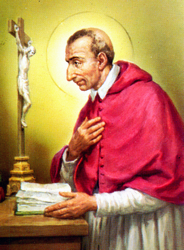Lives of the Saints
Our Models and Protectors
Spiritual Bouquet:
"Give thanks to the Father, who has made us worthy to share the lot of the Saints in the light."
St. Paul, Col. 1:12
November 4

Saint Charles Borromeo
Archbishop of Milan
(1538-1584)
Saint Charles Borromeo was born in 1538 in the castle of Arona on the borders of Lake Major, fourteen miles from Milan. He was the son of Count Gilbert Borromeo, a descendant of one of the most ancient families of Lombardy, very famous for its great men. The Count was known for his almsgiving and his rigorous fasts; it was his custom never to eat a meal without first giving alms. The Countess, Charles' mother, was also exceptionally virtuous. Their family was composed of two sons and four daughters, all of whom manifested in their lives the splendor of their Christian heritage. Their maternal uncle, John Angelus of Medici, became Pope Pius IV. Charles was clearly destined for the ecclesiastical vocation; all his preferences in study made it clear.
When he was twelve years old, a paternal uncle willed to him an abbey in commendam; and the child constantly reminded his father that this revenue was the patrimony of the poor. His father wept for joy, seeing his son's solicitude for the just application of his trust.
Count Gilbert died when Charles was twenty years old, and he was obliged to come home from Pavia where he had been studying law; he returned there, however, to complete his doctorate at the university after settling his affairs. One year later, when his maternal uncle became Pope Pius IV, he created Charles cardinal, and after another year nominated him Archbishop of Milan. The Pontiff detained him in Rome, however, seeing his extensive capacities and adding to these offices other administrative duties which ordinarily require the prudence of mature years. No one was disappointed in his services, despite the fact he was maintaining delicate papal relations with other nations, as protector of Portugal and the Low Countries, and was at the head of the Knights of Malta, the Orders of Carmel and Saint Francis, among other duties.
When the Council of Trent (1545-1563) was nearing its conclusion, Saint Charles, who had participated with authority in many of its twenty-five sessions, desired to leave Rome to attend to his diocese of Milan, a duty which his vicar general had carried out until that time. The urgency of the situation there persuaded the Pope to consent regretfully to his departure. Saint Charles intended to put into execution the reforming decrees of the Council, create seminaries and schools and in general restore discipline in the Church of Milan.
As Archbishop of Milan he enforced the observance of the decrees, and thoroughly restored the discipline of his see. Criticism hounded him there, but left him unmoved; he kept with him in his episcopal household of about one hundred persons, a certain priest who delighted in finding fault with whatever he did; he treated him with great consideration, and in his will left him a pension for life. He was very severe with himself, eating only once a day, and limiting himself often to bread and water. When someone suggested he should have a garden at Milan to get some fresh air, he replied that the Holy Scriptures should be the garden of a bishop.
The sermons of Saint Charles produced great fruits among all ranks of the people. When young he had manifested a speech defect with a tendency to speak too fast, but he overcame these handicaps with many efforts. A man who admired him said that he always forgot the orator himself when he preached, so transported was he by the great truths he heard explained, and the longest sermons of Saint Charles seemed short to him. Everywhere the holy Archbishop established schools of Christian doctrine, numbering in all seven hundred and forty, in which over three thousand catechists were employed, presiding over forty thousand students.
Once Saint Charles heard a cardinal who was a bishop of a small diocese say that his diocese was too small to require his constant residence there, as canon law required; Saint Charles said to him with force that the price of one soul is such as to merit the residence and entire time of the greatest of men. He himself visited the most remote corners of his diocese, traveling in mountainous regions amid the greatest dangers, which he regarded as nothing unusual, and unworthy of mention.
Inflexible in maintaining discipline, to his flock he was a most tender father. He would sit by the roadside to teach a poor man the Pater and Ave. During the great plague which broke out in Milan, which he had foretold as a chastisement for the disorders of the Carnival, he refused to leave, asking those who remonstrated with him if it were not more perfect to remain with one's flock than to abandon them in need, and adding that a bishop is obliged to choose what is most perfect. He was ever at the side of the sick and dying. He stripped his palace of literally everything to aid those who had lost their support in their fathers and spouses, even giving away his straw mattress. As he lived, so he died, having governed his church for twenty-four years and eight months. To the heroic sanctity of this faithful copy of the Good Shepherd, many miracles came to testify, through his relics and his intercession. In 1610 he was canonized by Pope Paul V.
The Lives of the Fathers, Martyrs and Principal Saints, by Rev. Alban Butler (Metropolitan Press: Baltimore, 1845), Vol. IV, October-December; Little Pictorial Lives of the Saints, a compilation based on Butler's Lives of the Saints and other sources by John Gilmary Shea (Benziger Brothers: New York, 1894).